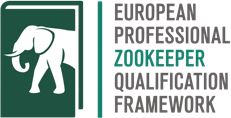It is essential that zoos maintain proper standards of hygiene, both in respect of the personal hygiene of the staff and that of the animal enclosures and treatment rooms. Within this topic there are four competencies:
- Cleaning and Cleanliness: zookeepers can maintain cleanliness and good hygiene practice in the workplace.
- Cleaning Safety: zookeepers can perform cleaning in accordance with the safety protocols and according to the instructions.
- Cleaning and Biology: zookeepers can perform cleaning in accordance with biological requirements of each species.
| Zookeepers working at Competent level can: | Zookeepers working at Proficient level can: | Zookeepers working at Expert level can: | |
|---|---|---|---|
| 3.3.1 Cleaning and Cleanliness | Demonstrate proper personal hygiene practices Clean enclosures to an agreed standard and according to a safe and appropriate daily cleaning regime Follow procedures for reporting situations in need of repair or maintenance (links to 3.2.4 Accommodation Safety and Security) Describe the consequences of poorly cleaned enclosures |
Compile daily maintenance reports appropriately and provide these to maintenance staff Clean enclosures to a high standard, as well as highly visible or difficult places Explain the differences between cleaning, sanitising and disinfection |
Supervise other staff while cleaning to ensure high standards of cleanliness Develop cleaning management plans for their department and ensure colleagues understand cleaning priorities Perform appropriate cleaning during quarantine or disease outbreak |
| 3.3.2 Cleaning Safety | Demonstrate compliance with the cleaning protocols Use cleaning products and cleaning equipment according to the instructions Recognise hazards related to cleaning products |
Establish safe cleaning regimes Supervise safe use of cleaning products and equipment |
Select suitable cleaning products, following specialist (e.g. a vet’s) recommendations |
| 3.3.3 Cleaning and Biology | Recognise the need to adjust the cleaning regime to account for species-/animal-specific situations (e.g. scent marking or removal of body fluids) | Implement changes to the cleaning regime in response to specific situations and report to supervisors | Produce long term cleaning plans, incorporating seasonal changes and biological needs Develop plans for their department which provide flexibility of cleaning regime and product selection to cover changing needs |
Resources
- Handbook DMZAA Unit 5: Enclosure Design & Maintenance in Zoos & Aquariums – Sparsholt College
- The Modern Zoo: Foundations for Management and Development – EAZA
- G. Hosey, V. Melfi and S. Pankhurst, Zoo Animals – Behaviour, Management, and Welfare, 2nd edn., 2013
- EAZA Standards for the Accommodation and Care of Animals in Zoos and Aquaria – EAZA
- …
Paths to fulfilment
- Diploma in Management of Zoos and Aquariums Animals (DMZAA) – Sparsholt College
- …
Last updated: 25/04/2018
